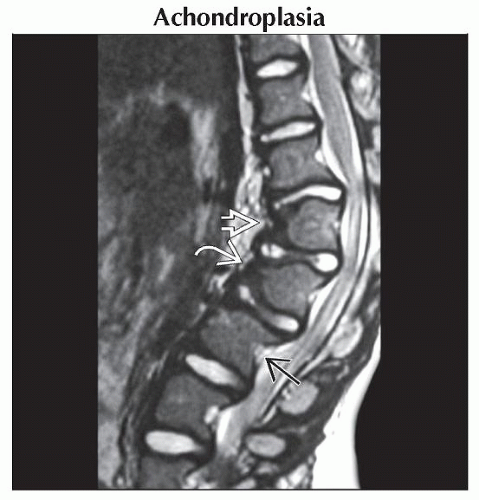Dwarfism with Major Spine Involvement
Catherine C. Roberts, MD
DIFFERENTIAL DIAGNOSIS
Common
Achondroplasia
Thanatophoric Dwarf
Spondyloepiphyseal Dysplasia
Less Common
Hypothyroidism, Child (Mimic)
Noonan Syndrome
Morquio Syndrome
Hurler Syndrome
Hunter Syndrome
Rare but Important
Progeria
Hypochondroplasia
Metatropic Dwarfism
Diastrophic Dwarfism
Kniest Dysplasia
Camptomelic Dysplasia
Osteoglophonic Dysplasia
Dyssegmental Dysplasia
ESSENTIAL INFORMATION
Helpful Clues for Diagnoses
Achondroplasia
Short, flat vertebral bodies; decreasing interpediculate distance L1 → L5
Posterior vertebral body scalloping
Hypoplastic upper lumbar vertebral bodies
Thanatophoric Dwarf
Platyspondyly with rounded anterior vertebral bodies
Spondyloepiphyseal Dysplasia
Ovoid or pear-shaped vertebrae in infancy
Central, anterior vertebral body beak
Odontoid hypoplasia
Hypothyroidism, Child (Mimic)
Congenital vertebral anomalies: Hemivertebrae, abnormal rib-vertebral articulations, platyspondyly
“Sail” vertebrae = upper lumbar vertebra with wedge or hook shape
Noonan Syndrome
Klippel-Feil anomaly
Scoliosis & kyphosis
Morquio Syndrome
Extensive vertebra plana
Central, anterior vertebral body beak
Diminutive or disappearing dens of axis
Hurler Syndrome
Anterior inferior vertebral body beak
Oval to biconvex vertebral bodies
Absent dens → atlantoaxial subluxation
Hunter Syndrome
Inferior beak similar to Hurler syndrome
Posterior vertebral body scalloping
Progeria
Infantile central notching retained
Hypochondroplasia
Decreased interpediculate distance L1 → L5
Kniest Dysplasia
Platyspondyly with narrow interpediculate distance
Coronal vertebral body clefts, infants
Camptomelic Dysplasia
Hypoplastic cervical vertebrae
Image Gallery
 Sagittal T2WI MR shows posterior vertebral scalloping
 , anterior beaking , anterior beaking  , as well as hypoplasia of L1 and L2. This results in a focal kyphosis , as well as hypoplasia of L1 and L2. This results in a focal kyphosis  . .Stay updated, free articles. Join our Telegram channel
Full access? Get Clinical Tree
 Get Clinical Tree app for offline access
Get Clinical Tree app for offline access

|